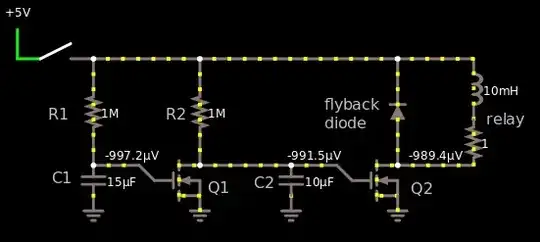You can make it with only:
- 2×Capacitors
- 2×Transistors
- 2×Resistors
The diode, inductor and the 1Ω is not part of the timing question.
The schematic looks like this:

Here's a link to the schematic so you can interact with it.
\$C_2\$ charges up faster than \$C_1\$ because the \$RC\$ constant is smaller for \$C_2\$. \$R_1×C_1>R_2×C_2\$. So \$C_2\$ will reach \$1.5\$V first which is when \$Q_2\$ starts conducting which will turn on the relay. Then \$C_1\$ reaches \$1.5\$V which opens \$Q_1\$ which closes \$Q_2\$ and the relay.
I don't know what your knee voltage is, AKA when the MOSFET starts conducting. If you use a BJT transistor instead then it might be easier, but whatever you got, use that. So I will call the start of the conducting point for knee, look up in your datasheet for your transistor that you will use. For a BJT transistor the knee voltage is typically \$0.7\$V, for a MOSFET it's all between \$1.5\$V and \$10\$V. There may be other weird MOSFET's that go below \$1.5\$V and above \$10\$V, but I haven't heard of them.
So \$T_1\$ will be 5 seconds and \$T_2\$ will be 6 seconds. When \$T_1\$ happens, \$Q_2\$ opens, When \$T_2\$ happens, \$Q_1\$ opens.
In order to calculate the timing more accurately, use these equations, they will put you in the ball park with the timing.
$$V_C=V_E×(1-e^{-\frac{t}{RC}})$$
\$V_C\$ = Voltage across capacitor
\$V_E\$ = Voltage you're feeding the resistor + capacitor (5V)
We want the \$R\$ in above equation. If we move things around we get the following equation:
$$R = \frac{-t}{C\ln({\frac{V_E-V_C}{V_E}})}$$
First we select \$C\$ because it is the most difficult to change, I say 10µF, or 47µF. I'll go with 10µF cause it's something that you are more likely to have laying around.
For \$R_2\$, these parameters will suffice:
\$V_C=\$ knee \$=1.5V\$
\$V_E=5V\$
\$t = T_1 = 5s\$
$$R_2=\frac{-5s}{(10µF)\ln({\frac{5V-1.5V}{5V}})}=1.29MΩ$$
If we set \$C_2\$ to \$47\$µF instead \$R_2\$ can be \$275\$kΩ.
For \$R_1\$, we want to close at \$t = T_2 =6s\$, everything else is the same.
$$R_1=\frac{-6s}{(10µF)\ln({\frac{5V-1.5V}{5V}})}=1.55MΩ$$
If we set \$C_1\$ to \$47\$µF instead \$R_1\$ can be \$331\$kΩ.
I didn't set the values in the schematic to what I calculated with the equations because I made the image before I wrote the text, meh.


